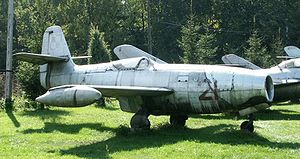Yakovlev Yak-23 Video - USAF Overview
|
|
Yakovlev Yak-23
Yak-23

Picture - Yak-23 in Muzeum Orła Białego in Poland
Role: Fighter aircraft
Manufacturer: Yakovlev
First flight: 8 July 1947
Introduced: 1949
Retired: 1951 (Soviet Union)
1956 (Poland)
Primary users: Soviet Air Force
Polish Air Force
Romanian Air Force
Produced: October 1949-1950
Number built: 310
Developed from: Yakovlev Yak-17
Yakovlev Yak-19
The Yakovlev Yak-23 (in Russian Як-23, USAF/DoD reporting name "Type 28", NATO reporting name "Flora") was a jet fighter developed in the USSR in the 1940s, used in early 1950s.
Design and development
The Yak-23 was developed as a simple lightweight jet fighter, on Yakovlev's own initiative. It was a development of the earlier Yak-15 and Yak-17 fighters, retaining their non-conventional layout with a jet engine in the fuselage nose and exhaust under the cockpit, but the construction was all new. Its wings were derived from the Yak-19. The Yak-23 used a Soviet copy of the British Rolls-Royce Derwent V turbojet engine, produced as the Klimov RD-500. It first flew on July 8, 1947. After successful flights, it underwent state trials in 1948 and was accepted for series production. It was evaluated as highly maneuverable, with a good acceleration and take-off and climb capabilities thanks to high thrust-to-weight ratio. Faults were poor directional stability at speeds around Mach 0.86 and lack of cockpit pressurization. Despite being one of the best straight-wing jet fighters, it was inferior to new swept-wing designs.
Operational history
The first aircraft were produced in a factory in Tbilisi in October 1949. In late 1949 they entered Soviet air force service, and were also ordered for export in 1949-50. The Yak-23 was quickly replaced in the Soviet service with the more complicated swept-wing MiG-15, which offered superior performance. In all, only 310 Yak-23 aircraft were built before production ended in 1950. Apart from the fighter, the Yak-23UTI two-seat trainer was developed, with an instructor's cockpit extended towards the aircraft nose. Sources differ, whether it was produced at all or in a small batch.
Small numbers of Yak-23 were exported to Czechoslovakia (20 from 1949, named S-101), Bulgaria (from 1949), Poland (about 100, from 1950), Romania (62, from 1951) and probably Albania. Poland and Czechoslovakia acquired license of Yak-23, but didn't start production in favour of the MiG-15. Yak-23s were withdrawn by the late 1950s. They were not used in combat (there are reports of US pilots encountering Yak-23s during the Korean War, but their presence in North Korea is not confirmed).
US testing
A single Yak-23 was acquired by US intelligence, via Yugoslavia, in November, 1953. It was a Romanian Yak-23 flown by Mihail Diaconu who defected with it. The aircraft arrived disassembled, and was shipped to the Air Force Test and Evaluation Center at Wright Field near Dayton, Ohio. It was reassembled and made operational for several flight tests, during which time it was disguised with U.S. markings. Efforts were made to keep the aircraft's identity secret, and it was only flown in the early morning. On one occasion it was passed on the runway by a formation of F-86's, whose pilots inquired as to the plane's identity. A story was conceived that the aircraft was a Bell X-5, which had a similar layout. At the completion of design and flight evaluations the aircraft was again disassembled and shipped quietly back to Yugoslavia in its original paint scheme.
Records
On September 21, 1957, the Polish pilot Andrzej Abłamowicz set two FAI world records on Yak-23 with civilian markings SP-GLK, in its weight class, climbing at 3,000 m (9,843 ft) in 119 seconds (4,962.6 ft/min) and at 6,000 m (19,685 ft) in 197 seconds (5,995.4 ft/min). This plane was withdrawn in 1961, being possibly the last Yak-23 used in the world.
Variants
Yak-23 Fighter version, serial built. Yak-23UTI Two-seat training version with longer fuselage and lighter armament, prototype only. Yak-23DC Romanian-built two-seat training version. Four Yak-23 single-seaters were converted in 1956 by ASAM Pipera, two of them belonging to the Bulgarian AF. S-101 Czech designation.
Operators
Bulgaria
Bulgarian Air Force received at least 12 aircraft in 1949.
Czechoslovakia
Czechoslovak Air Force received 20 aircraft in 1949.
Poland
Polish Air Force received about 100 aircraft operated between 1950 and 1956
Romania
Romanian Air Force received 62 aircraft in 1951, used them until 1958
Soviet Union
Soviet Air Force operated aircraft between 1949 and 1951.
United States
United States Air Force operated one aircraft in November 1953 for flight tests.
Specifications (Yak-23)
General characteristics
Crew: one
Length: 8.12 m (26 ft 8 in)
Wingspan: 8.73 m (28 ft 8 in)
Height: 3.31 m (10 ft 10 in)
Wing area: 13.50 m² (145 ft²)
Empty weight: 1,980 kg (4,356 lb)
Loaded weight: 3,384 kg (7,445 lb)
Max takeoff weight: kg (lb)
Powerplant: 1x— Klimov RD-500 turbojet, 15.6 kN (3,500 lbf)
Performance
Maximum speed: 923 km/h (577 mph)
Range: 1,400 km (875 mi)
Service ceiling: 14,800 m (48,500 ft)
Rate of climb: 41.4 m/s (8150 ft/min)
Wing loading: 251 kg/m² (51 lb/ft²)
Thrust/weight: 0.46
Armament
Guns: 2 x— 23 mm Nudelman-Rikhter NR-23 with 90 rpg
Related development
Yakovlev Yak-15
Yakovlev Yak-17
Yakovlev Yak-19
Comparable aircraft
Mikoyan-Gurevich MiG-9
FMA Pulqui
Living Warbirds: The best warbirds DVD series.
Source: WikiPedia